P2Y1 receptor modulation of the pre-Bötzinger complex inspiratory rhythm generating network in vitro
- PMID: 17267553
- PMCID: PMC6673186
- DOI: 10.1523/JNEUROSCI.3948-06.2007
P2Y1 receptor modulation of the pre-Bötzinger complex inspiratory rhythm generating network in vitro
Abstract
ATP is released during hypoxia from the ventrolateral medulla (VLM) and activates purinergic P2 receptors (P2Rs) at unknown loci to offset the secondary hypoxic depression of breathing. In this study, we used rhythmically active medullary slices from neonatal rat to map, in relation to anatomical and molecular markers of the pre-Bötzinger complex (preBötC) (a proposed site of rhythm generation), the effects of ATP on respiratory rhythm and identify the P2R subtypes responsible for these actions. Unilateral microinjections of ATP in a three-dimensional grid within the VLM revealed a "hotspot" where ATP (0.1 mM) evoked a rapid 2.2 +/- 0.1-fold increase in inspiratory frequency followed by a brief reduction to 0.83 +/- 0.02 of baseline. The hotspot was identified as the preBötC based on histology, overlap of injection sites with NK1R immunolabeling, and potentiation or inhibition of respiratory frequency by SP ([Sar9-Met(O2)11]-substance P) or DAMGO ([D-Ala2,N-MePhe4,Gly-ol5]-enkephalin), respectively. The relative potency of P2R agonists [2MeSADP (2-methylthioadenosine 5'-diphosphate) approximately = 2MeSATP (2-methylthioadenosine 5'-triphosphate) approximately = ATPgammas (adenosine 5'-[gamma-thio]triphosphate tetralithium salt) approximately = ATP >> UTP approximately = alphabeta meATP (alpha,beta-methylene-adenosine 5'-triphosphate)] and attenuation of the ATP response by MRS2179 (2'-deoxy-N6-methyladenosine-3',5'-bisphosphate) (P2Y1 antagonist) indicate that the excitation is mediated by P2Y1Rs. The post-ATP inhibition, which was never observed in response to ATPgammas, is dependent on ATP hydrolysis. These data establish in neonatal rats that respiratory rhythm generating networks in the preBötC are exquisitely sensitive to P2Y1R activation, and suggest a role for P2Y1Rs in respiratory motor control, particularly in the P2R excitation of rhythm that occurs during hypoxia.
Figures
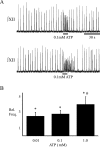

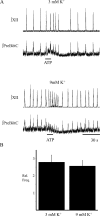



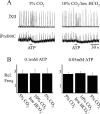

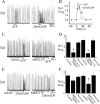
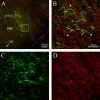


Similar articles
-
ATP sensitivity of preBötzinger complex neurones in neonatal rat in vitro: mechanism underlying a P2 receptor-mediated increase in inspiratory frequency.J Physiol. 2008 Mar 1;586(5):1429-46. doi: 10.1113/jphysiol.2007.143024. Epub 2008 Jan 3. J Physiol. 2008. PMID: 18174215 Free PMC article.
-
Release of ATP by pre-Bötzinger complex astrocytes contributes to the hypoxic ventilatory response via a Ca2+ -dependent P2Y1 receptor mechanism.J Physiol. 2018 Aug;596(15):3245-3269. doi: 10.1113/JP274727. Epub 2017 Jul 27. J Physiol. 2018. PMID: 28678385 Free PMC article.
-
Purinergic modulation of preBötzinger complex inspiratory rhythm in rodents: the interaction between ATP and adenosine.J Physiol. 2011 Sep 15;589(Pt 18):4583-600. doi: 10.1113/jphysiol.2011.210930. Epub 2011 Jul 25. J Physiol. 2011. PMID: 21788352 Free PMC article.
-
Sensing arterial CO(2) levels: a role for medullary P2X receptors.J Auton Nerv Syst. 2000 Jul 3;81(1-3):228-35. doi: 10.1016/s0165-1838(00)00118-1. J Auton Nerv Syst. 2000. PMID: 10869726 Review.
-
Targeting P2 receptors in purinergic signaling: a new strategy of active ingredients in traditional Chinese herbals for diseases treatment.Purinergic Signal. 2021 Jun;17(2):229-240. doi: 10.1007/s11302-021-09774-x. Epub 2021 Mar 22. Purinergic Signal. 2021. PMID: 33751327 Free PMC article. Review.
Cited by
-
Blockade of neurokinin-1 receptors in the ventral respiratory column does not affect breathing but alters neurochemical release.J Appl Physiol (1985). 2015 Mar 15;118(6):732-41. doi: 10.1152/japplphysiol.00884.2014. Epub 2015 Jan 29. J Appl Physiol (1985). 2015. PMID: 25635003 Free PMC article.
-
Activation of Astrocytes in the Persistence of Post-hypoxic Respiratory Augmentation.Front Physiol. 2021 Oct 8;12:757731. doi: 10.3389/fphys.2021.757731. eCollection 2021. Front Physiol. 2021. PMID: 34690820 Free PMC article.
-
Neurochemical and electrical modulation of the locus coeruleus: contribution to CO2drive to breathe.Front Physiol. 2014 Aug 5;5:288. doi: 10.3389/fphys.2014.00288. eCollection 2014. Front Physiol. 2014. PMID: 25183958 Free PMC article. Review.
-
Effects of Preinjury and Postinjury Exposure to Caffeine in a Rat Model of Traumatic Brain Injury.J Caffeine Adenosine Res. 2020 Mar 1;10(1):12-24. doi: 10.1089/caff.2019.0012. Epub 2020 Mar 4. J Caffeine Adenosine Res. 2020. PMID: 32181443 Free PMC article.
-
On the existence of a central respiratory oxygen sensor.J Appl Physiol (1985). 2017 Nov 1;123(5):1344-1349. doi: 10.1152/japplphysiol.00194.2017. Epub 2017 May 18. J Appl Physiol (1985). 2017. PMID: 28522760 Free PMC article. Review.
References
-
- Brosenitsch TA, Adachi T, Lipski J, Housley GD, Funk GD. Developmental downregulation of P2X3 receptors in motoneurons of the compact formation of the nucleus ambiguus. Eur J Neurosci. 2005;22:809–824. - PubMed
-
- Dale N, Gilday D. Regulation of rhythmic movements by purinergic neurotransmitters in frog embryos. Nature. 1996;383:259–263. - PubMed
Publication types
MeSH terms
Substances
LinkOut - more resources
Full Text Sources
Miscellaneous
